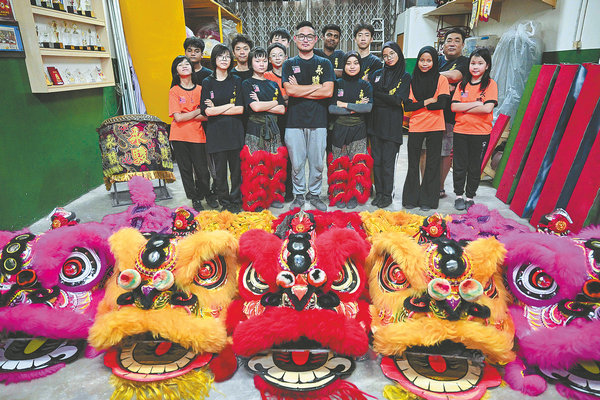Lion dance roars with shared values

Members of the Malaysian Yong Jun Lion Dance Association after a rehearsal in Selangor in September. [Photo/Xinhua]
The powerful people-to-people bonds between China and Malaysia take many expressions considering the range of shared cultural and traditional values between the two nations.
The Malay people have taken great interest in the lion dance, a tradition that emerged over a thousand years ago in China and has many admirers in modern Malaysia.
Among them is Adzwin Puteri Faizal, a petite young woman from Rawang in Selangor state, who is part of a troupe under the locally renowned Yong Jun Lion Dance Association.
With fluid and energetic movements, the 18-year-old Adzwin plays the role of the lion's tail and moves as one with her partner, using classic springs on poles, gracefully leaping and steadily balancing.
"When the master performed at our school for the first time, I was captivated. It looked so cool," she says.
Having been part of the troupe for the past five years, Adzwin honed her skills and built up her experience in the art form along with her teammates comprising Malaysians of other ethnic groups aged 10 to 18.
The lion dance in Malaysia shares its roots with the Chinese lion dance, specifically from the southern lion dance style. It arrived in Malaysia with Chinese immigrants and took root.
Initially, the lion dance was performed during Chinese festivals and celebrations, but with the blending of Malaysia's ethnicities and cultures, it gradually crossed ethnic and religious boundaries, becoming a beloved cultural activity for all communities. Its cultural value is widely recognized by the public.
Behind Adzwin's involvement in the lion dance association lies her family's firm support, mainly through her father Faizal Salehudin's passion for the art form in his youth.
Thirty years ago, when he was still a student, Faizal was also drawn to the lion dance, but in those days financial constraints and having to travel a long distance prevented him from pursuing his interest.
"It's a culture. We want to learn about other ethnic groups' cultures, because culture is universal," Faizal says.
Now, his daughter has rekindled Faizal's love for the lion dance. As a ride-hailing driver, he takes Adzwin to the training grounds every weekend night, accompanying her throughout practice and recording her progress on his smartphone.
Adzwin's lion dance master, Chan Yong Zhen, started learning lion dance at age 16. It has been 17 years since Chan immersed himself in this culture. The Lion Dance Association was founded by his father and is now carried on and developed by Chan. Adzwin is one of the outstanding students he has trained, with her dedication and focus on being truly moving.
"Don't underestimate her because she's a woman; she's very strong and can lift her partner with ease to complete high-difficulty moves," says Chan.
"In earlier generations, it was difficult for people from other ethnic groups and women to learn lion dance, but things have changed. The uniqueness and inclusiveness of lion dance have allowed us to build a family here," he says.
This year marks the 50th anniversary of the establishment of diplomatic ties between China and Malaysia. Both sides celebrate the lion dance as a form of shared history, and jointly promote and safeguard the heritage.
